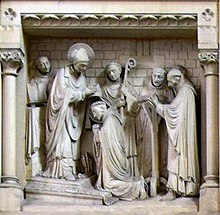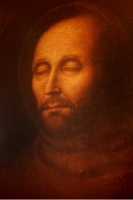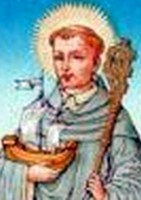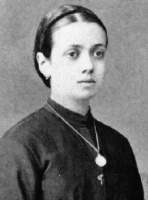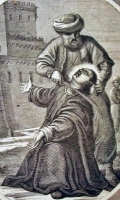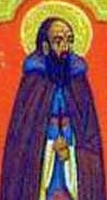St. Ursmar
Feastday: April 19
Death: 713
Benedictine abbot-bishop, and missionary. Perhaps a native of Ireland, he served as abbot-bishop of the abbey of Lobbes, on the Sambre, in Flanders, Belgium, from which he organized exceedingly successful missionary efforts in the region.
Ursmar receives holy orders as abbot of Lobbes Abbey in 691, probably by Saint Lambertus, bishop of Maastricht (19th-century relief in the Church of Saint Ursmar in Lobbes)
Ursmar of Lobbes[1] (died 713) was a missionary bishop in the Meuse and Ardennes region in present-day Belgium, Germany, Luxemburg and France. He was also the first abbot of Lobbes Abbey.
As many missionaries in the 7th and 8th century, he may have been of Irish origin. He was appointed abbot of Lobbes in 691 by the Frankish king Pippin II.[2] He is also credited with the foundation of Aulne Abbey and Wallers Abbey.
Saint Ursmar is a Catholic saint, whose feast day is April 19.[3] His sarcophagus is in the crypt of the parish church in Lobbes (as well as the sarcophagus of his successor, Saint Ermin. A Life was written by Heriger of Lobbes
St. Hermogenes
Feastday: April 19
Death: 4th century
Armenian martyr with Aristonicus, Expeditus, Galata, Gaius, and Rufus. They suffered at Melitene.
Pope Saint Leo IX
புனிதர் ஒன்பதாம் லியோ
152ம் திருத்தந்தை:
பிறப்பு: ஜூன் 21, 1002
எகிஷெய்ம், அல்சாஸ், ஸ்வாபியா, புனித ரோமப் பேரரசு
இறப்பு: ஏப்ரல் 19, 1054 (வயது 51)
ரோம், திருத்தந்தையர் மாநிலங்கள், புனித ரோமப் பேரரசு
புனிதர் பட்டம்: கி.பி. 1082
திருத்தந்தை ஏழாம் கிரகோரி
நினைவுத் திருநாள்: ஏப்ரல் 19
திருத்தந்தை ஒன்பதாம் லியோ, ஜெர்மன் பிரபு குடும்பத்தில் பிறந்தவர். இவர் பெற்றோர் இவருக்கு 'புரூனோ' (Bruno of Egisheim-Dagsburg) என்று பெயர் சூட்டினர். புரூனோ, ஃபிரான்ஸ் நாட்டிலுள்ள “டெளள்” (Toul) என்ற ஊரில் கல்வி பயின்றார்.
இவர் படிக்கும்போதிலிருந்தே இவருக்கு ஏராளமான நண்பர்கள் இருந்தனர். புரூனோ சிறு வயதிலிருந்தே பூசை உதவி செய்வதிலும், பாடல் குழுவோடு இணைந்து திருப்பலியில் பாடல் பாடுவதிலும், ஆடம்பர திருப்பலியில் பங்கெடுப்பதிலும், அதிக ஆர்வம் காட்டிவந்தார். இறைவன் மீது அளவற்ற அன்பு கொண்டிருந்தார். தினமும் திருப்பலியில் பங்கெடுத்த புரூனோ, தானும் குருவாக வேண்டுமென்று ஆசைப்பட்டு குருவானார்.
புரூனோ குருவான பிறகு, ஜெர்மனியிலிருந்த அரசர் இரண்டாம் கோன்ராட் (Konrad II) அவர்களின் குடும்பத்திற்கு ஆன்மீக வழிகாட்டியாக தேர்ந்தெடுக்கப்பட்டார். அப்போது இவர் திருச்சபையில் இருந்த அரசியலைப் பற்றியும் படித்தார். அதன்பிறகு ஃபிரான்சு நாட்டிற்கு இறையியல் படிப்பதற்காக அனுப்பப்பட்டார்.
அப்போது இவர் அப்போஸ்தலர் சீமோனின் வாழ்க்கை வரலாற்றை படித்து, அவரால் ஈர்க்கப்பட்டார். பின்னர் இறையியல் படிப்பை முடித்தபிறகு இத்தாலி நாட்டில் இருந்த அரசர் குடும்பத்திற்கு மீண்டும் ஆன்மீக வழிகாட்டியாக தேர்ந்தெடுக்கப்பட்டார்.
பின்னர் இத்தாலி நாட்டின் ஆயரின் உதவியாளராக பணியாற்றினார். அப்போது இத்தாலி மறைமாநிலத்திலிருந்த ஏழை எளியவர்க்கு ஆயரின் உதவியுடன் பலவிதமான உதவிகளை செய்தார்.
மற்றவர்களுக்கு உதவி செய்வதில் அளவில்லா மகிழ்ச்சி அடைந்தார். அப்போது திருச்சபையில் இருந்த கத்தோலிக்க ஆலயங்களின் வழியாகவும், துறவற இல்லங்களின் வழியாகவும், நாள்தோறும் ஏழைகளுக்கு உணவு கொடுத்தும், அடிப்படை வசதிகளை செய்து கொடுத்தும் வந்தார். இவரின் தாராள குணத்தை அறிந்த ஜெர்மனி மற்றும் பிரான்சிலுள்ள ஆயர்களும் புரூனோவுக்கு ஏழைகளை பராமரிக்க தேவையான உதவிகளை செய்தனர். பின்னர் இவர் ஃபிரான்சிலுள்ள லையன் (Lyon) என்ற மறைமாநிலத்திற்கு ஆயராக தேர்ந்தெடுக்கப்பட்டார்.
புரூனோ ஆயராக இருந்தபோது திருத்தந்தை “டமாசஸ்” (Damasus) திருத்தந்தையாக தேர்ந்தெடுக்கப்பட்டார்.
23 நாட்கள் மட்டுமே திருத்தந்தையாக இருந்தவர், கடுமையான காய்ச்சலால் தாக்கப்பட்டு இறந்துப்போனார். அதனால் அவரைப் பின்பற்றி திருச்சபையை வழிநடத்த புரூனோ அவர்களை திருத்தந்தையாக தேர்ந்தெடுத்தனர்.
1049ம் ஆண்டு புரூனோ "ஒன்பதாம் லியோ" என்று பெயர் மாற்றம் பெற்று திருத்தந்தையானார். திருத்தந்தை ஒன்பதாம் லியோ திருச்சபையின் மோசமான நிலையைப் பார்த்து மிகவும் வேதனைப்பட்டார். இதனால் திருத்தந்தையான சிறிது நாட்களிலேயே ஆயர்களின் மாநாட்டை கூட்டினார். இம்மாநாட்டிற்கு பொதுமக்களையும் வரவழைத்தார். இதில் பங்குபெற்ற ஒவ்வொருவருமே திருச்சபையில் இருக்கும் குறை, நிறைகளைப் பற்றி பகிர்ந்துகொள்ள வலியுறுத்தப்பட்டது. அம்மாநாட்டின் இறுதியில் தனிப்பட்ட முறையில் ஐரோப்பாவிலிருந்த ஒவ்வொரு கிறிஸ்தவ ஆலயங்களையும், அரசர்களையும், மக்களையும் திருத்தந்தை சந்தித்து உரையாடினார். ஆடம்பர திருப்பலி நிறைவேற்றி, அருமையான மறையுரை வழங்கினார். புதிய ஆலயங்களும், துறவற மடங்களும் கட்ட அடிக்கல் நாட்டினார்.
ஐரோப்பிய நாடுகளைப் பார்வையிட்டபோது, அரசர்களால் மக்கள் படும் வேதனையை, திருத்தந்தை கண்கூடாக பார்த்து மிகவும் வேதனைப்பட்டார். இதனால் மக்களின் பசியையும், அவர்களின் அவல நிலையையும் போக்க தன் சொந்த வீட்டு பணத்தை எடுத்து உதவிசெய்தார். மக்களை வழிநடத்த நல்ல குருக்களை உருவாக்கினார். இதனால் ஐரோப்பிய அரசர்கள் மிகவும் ஆத்திரமடைந்து திருத்தந்தை ஒன்பதாம் லியோவை பிடித்து சிறையில் அடைத்தார்கள். ஏறக்குறைய ஒன்பது மாதங்கள் கழித்து சிறையிலிருந்து விடுவித்தனர். ஆனால் இவர் மேல் தொடர்ந்து பல பொய்க்குற்றங்கள் சாட்டப்பட்டன.
பின்னர் 1054ம் ஆண்டு, மார்ச் மாதம், 12ம் நாள், ரோம் சென்று திருத்தந்தை பதவியிலிருந்து விலகினார். 52 வயதான திருத்தந்தை ஒன்பதாம் லியோ வெறும் ஐந்து ஆண்டுகள் மட்டுமே திருத்தந்தையாக பதவி வகித்தார். ஆனால் இவ்வைந்து ஆண்டுகளில் கத்தோலிக்க திருச்சபைக்கு இவர் ஆற்றிய பணி எண்ணிலடங்காது.
பின்னர் 1054ம் ஆண்டு, ஏப்ரல் மாதம், 19ம் நாள், ரோமில் உள்ள புனித பீட்டர் பேராலயத்தில் இறந்தார்.
இவரது உடல், பேதுரு பேராலயத்திலுள்ள, திருத்தந்தையர்களை அடக்கம் செய்துள்ள கல்லறையில், புனித யோசேப்பு பலிபீடத்தின் வலதுபுறத்தில் அடக்கம் செய்யப்பட்டுள்ளது.
இவர் இறந்தாலும் மக்களின் மனங்களில் புனிதராகவே வணங்கப்பட்டு வருகின்றார்.
Also known as
• Apostolic Pilgrim
• Bruno of Egisheim
• Bruno of Eguisheim-Dagsburg
• Pilgrim Pope
Profile
Son of Count Hugh of Egisheim. Cousin of Emperor Conrad II. Chapter canon of Saint Stephen's, Toul, France. Deacon. Soldier and officer in the imperial army. In 1021, while still in the military, he was chosen bishop of Toul, France, a position he held for 20 years. Commanded troops under emperor Conrad II in the invasion of Italy in 1026. Very disciplined himself, he brought order to the monasteries in his diocese, discipline to the clergy, and the Cluniac reform to many of his houses. Mediator between France and the Holy Roman Empire. Chosen 151st pope with the support of the Roman citizens and Henry III of Germany.
Leo brought his reforming, disciplinary ways to the Church as a whole, reforming houses and parishes, fighting simony, enforcing clerical celibacy, encouraging liturgical development and the use of chant. He brought Hildebrand, later Pope Saint Gregory VII, to Rome as his spiritual advisor. Fought the coming Great Schism between the Eastern and Western churches. He received the nickname of Pilgrim Pope due to his travels through Europe, enforcing his reforms, insisting that his bishops, clergy, and councils follow suit. Held synods at Pavia, Italy, in Rheims, France, in Mainz, Germany, and in Vercelli, Italy where he condemned the heresy of Berengarius of Tours. Authorized the consecration of the first native bishop of Iceland. Peacemaker in Hungary. Proposed that Popes be elected only by cardinals.
Leo's papacy was marred by his military action. He added new Italian regions to the papal states, and when Normans invaded these areas in 1053, he personally led an army to throw them out. This resulted in wide-spread criticism, defeat in the field, his capture at Civitella, and several months imprisonment at Benevento, Italy. He spent his time there well, learning Greek to better understand the writings of the Eastern Church, but his health suffered badly, and he died soon after his release.
Born
21 June 1002 at Eguisheim, Alsace, France as Bruno of Eguisheim-Dagsburg
Papal Ascension
12 February 1049
Died
19 April 1054 in Saint Peter's Basilica, Rome, Italy of natural causes
Canonized
• 1082 by Pope Saint Gregory VII
• 1887 by Pope Blessed Victor III
Patronage
Sessa Aurunca, Italy
Saint Alphege of Winchester
Also known as
• Alphege the Martyr
• Alphege of Canterbury
• Alfege, Alphage, Alphege, Alphegus, Elphege, Godwine, Ælfheah, Aelfheah, Elfego, Elfege
Additional Memorial
8 June (translation of his relics)
Profile
Born to the nobility but gave it up to become a young monk at Deerhurst Abbey in Gloucestershire, England. Monk, anchorite, and then abbot at Bath Abbey; known for his personal piety and austerity. Bishop of Winchester, England in 984. Built several churches, installed a cathedral organ so large that it could be heard a mile away, and his charity was so great that there were reported to be no beggars in his diocese. May have helped negotiate a peace treaty in 994 which ended some Viking raids.
Archbishop of Canterbury, England in 1006. Encouraged devotion to Saint Dunstan of Canterbury. Translated the relics of Saint Swithun to Canterbury. In 1011 Danes began raiding again, laid seige to Canterbury, sacked the town, and captured Alphege along with several other Church officials, all of whom were held for ransom. Reported to have healed many of sick Danes by praying over them and feeding them blessed bread. Alphege refused to approve the payment of ransom for himself, and after several months was murdered by angry drunken Vikings, the first archbishop of Canterbury to die violently. Saint Thomas Becket was praying for Saint Alphege's intercession just before he was murdered.
Born
• 954 in Weston, Somerset, England
• Anglo-Saxon
Died
• beaten with stones and ox bones, then struck on the head with the blunt edge of an axe on 19 April 1012 in Greenwich, Kent (part of modern London), England
• interred in Saint Paul's Cathedral
• re-interred in Canterbury by King Canute in 1023
• his shrine was re-built and expanded in the early 12th century by Saint Anselm of Canterbury
• remains found incorrupt in 1105
• after a fire in the cathedral in 1174, Alphege's relics were re-interred by the high altar
Canonized
1078 by Pope Saint Gregory VII
Patronage
• Greenwich, England
• kidnap victims
• Solihull, England
Saint Expeditus of Melitene
Also known as
Elpidius, Expedite
Profile
Possibly legendary. Unclear whether his name led to his association with expeditious matters, or the other way around. This association led to his becoming the patron of people who had to deliver things on time.
Patronage
• against procrastination
• for expeditious solutions
• merchants
• navigators
• prompt solutions
Representation
• young Roman soldier holding aloft a cross
• young Roman soldier holding aloft a banner with the word "hodie" (latin for 'today')
Blessed Bernard of Sithiu
Also known as
• Bernard of Maguellone
• Bernard the Penitent
Profile
To atone for the sins of his early life, including a murder, Bernard lived in complete poverty, wearing rags, eating whatever came to hand, if anything, travelling barefoot from one holy place to another, and living as a hermit between pilgrimages. In 1178 he settled near the abbey of Sithiu and spent his remaining four years in private penance and prayer.
Died
19 April 1182 in the monastery of Saint-Bertin, Thérouanne region, France of natural causes
Saint Gerold of Saxony
Also known as
• Gerold of Großwalsertal
• Gerold of Grosswalsertal
• Gerold of Vorarlberg
• Adam of...
Profile
Born to the Saxon nobility. Donated land to the monastery of Einsiedeln, Switzerland where his sons, Cuno and Ulric became monks. Retired to live as a hermit near Mitternach, Germany.
Born
Saxony (part of modern Germany)
Died
16 April 978 of natural causes
Blessed James Duckett
Profile
London bookseller. Convert to Catholicism. Married and father of one son. Arrested several times for printing and selling Catholic books before finally being executed for the crime. Martyr.
Born
at Gilfortrigs, Skelsmergh, Westmorland, England
Died
hanged on 19 April 1602 at Tyburn, London, England
Beatified
15 December 1929 by Pope Pius XI
Patronage
• book sellers
• publishers
Blessed Ramon Llach-Candell
Profile
Priest. Member of the Sons of the Holy Family. Treasurer. Teacher. Director of several centers run by the Sons. Writer and poet. One of the Martyrs of the Spanish Civil War.
Born
24 May 1875 in Torelló, Barcelona, Spain
Died
• 19 April 1937 in Montcada, Barcelona, Spain
• his remains were never found
Beatified
13 October 2013 by Pope Francis
Blessed Jaume Llach-Candell
Profile
Priest. Member of the Sons of the Holy Family. One of the Martyrs of the Spanish Civil War.
Born
1 October 1878 in Torelló, Barcelona, Spain
Died
• 19 April 1937 in Montcada, Barcelona, Spain
• remains were never located
Beatified
13 October 2013 by Pope Francis
Saint Apollonius the Priest
Profile
Fourth-century priest. Martyred with five unnamed Christians in the persecutions of Diocletian.
Died
drowned in Alexandria, Egypt
Saint George of Antioch
Profile
Monk. Bishop of Antioch, Pisidia. Attended the Second Council of Nicea in 787. Opposed the iconoclasts, for which he was exiled by Emperor Leo V, the Armenian.
Died
815 of natural causes
Saint Martha of Persia
Profile
Daughter of Saint Pusicio. Nun. Martyred in the persecutions of Shapur II.
Died
Easter, 341 in Persia
Saint Crescentius of Florence
Profile
Sub-deacon in Florence, Italy. Spiritual student of Saint Zenobius and Saint Ambrose.
Died
c.396
Saint Vincent of Collioure
Profile
Martyred in the persecutions of Diocletian.
Died
c.304 in Collioure, Languedoc (in modern France)
Saint Aristonicus of Melitene
Profile
Martyr.
Born
4th century Armenian
Died
at Melitene, Armenian
Saint Galata of Melitene
Profile
Martyr.
Born
4th century Armenian
Died
at Melitene, Armenian
Saint Gaius of Melitene
Profile
Martyr.
Born
4th century Armenian
Died
at Melitene, Armenian
Saint Rufus of Melitene
Profile
Martyr.
Born
4th century Armenian
Died
at Melitene, Armenian
Martyrs of Carthage
Profile
A group of Christians martyred in the persecutions of Decius. We know little more than the names - Aristo, Basso, Credula, Donato, Ereda, Eremio, Fermo, Fortunata, Fortunio, Frutto, Julia, Mappalicus, Martial, Paul, Venusto, Victorinus and Victor.
Died
250 in prison in Carthage, North Africa (modern Tunis, Tunisia)
Also celebrated but no entry yet
• Emma of Saxony
புனித_எம்மா (-1038)
ஏப்ரல் 19
இவர் (#StEmma) பதினொன்றாம் நூற்றாண்டில், தற்போதைய பரேமன் என்ற இடத்தில் இருந்த ஒரு செல்வச் செழிப்பான குடும்பத்தில் பிறந்தார்.
இளம்வயதில் கடுஞ்சினம் கொள்ளக்கூடிய வராக இருந்தார் இவர்.
இவர் லியூட்ஜர் என்பவருக்கு மணம் முடித்துக் கொடுக்கப்பட்டார். இவர்கள் இருவருக்கும் இறைவன் ஓர் ஆண்குழந்தையைத் தந்தார்.
இப்படி வாழ்க்கை நகர்கையில், இரஷ்யாவிற்குச் சென்ற இவருடைய கணவர் இறந்தார். இது இவருடைய வாழ்க்கையில் பெரிய மாற்றத்தை ஏற்படுத்தியது.
இதனால் முன்கோபியாக இருந்த இவர், அமைதியின் வடிவாய் மாறினார்; தன்னிடம் இருந்ததை ஏழைகளுக்கும் பல கோயில்களுக்கும் வாரி வாரி வழங்கத் தொடங்கினார்.
இறுதியாக இவருடைய மகனை இறைப்பணிக்கு அர்ப்பணித்துவிட்டு, இவர் நிம்மதியாக இறையடி சேர்ந்தார்.
பல ஆண்டுகளுக்குப் பின் இவருடைய உடல் தோண்டி எடுக்கப்பட்டபோது, இவரது உடல் முழுவதும் சிதைந்து போயிருக்க, கொடுத்துக் கொடுத்துச் சிவந்த இவரது கைகள் மட்டும் அழியாமல் இருந்தன.
Saint Emma, also known as Emma of Lesum, or Emma of Stiepel, lived in the city that is Bremen today. She is the first female inhabitant of the city to be known by name.
Emma lived in the early 11th century, and was born into the Immedinger family. The Immedingers were Saxon nobility descended from the legendary King Widuking, who fought againt Charlemange.
Emma's father was a count, and her brother a bishop (Meinwerk of Paderborn). She married Liudger, the son of a Saxon duke. Their marriage resulted in one child, a boy named Imad. He would become bishop of Paderborn in 1051.
Little specific information about St. Emma survives. Legend states that she had a violent temper when she was young.
Emma's husband made a visit to Russia in 1011, fell ill and died. Following this tragedy, Emma withdrew into her faith. Her temperament became mild. She was a great benefactor of churches, establishing many small parishes. She donated to the Bremen Cathedral. Her concern for the poor was legendary.
After her death, she was buried in a tomb in Bremen Cathedral. her tomb was opened. Her body had turned to dust exception for her right hand, which she used to give gifts. Her intact hand was sent to the abbey of St. Ludger at Werden.
She was venerated as a saint following her death, but there are no official dates for her beatification or canonization. She has two known feast days, December 3, which is the recorded date of her death in 1038, and April 19.
Hemma of Gurk (German: Hemma von Gurk; c. 995 – 27 June 1045),[2] also called Emma of Gurk (Slovene: Ema Krška), was a noblewoman and founder of several churches and monasteries in the Duchy of Carinthia. Buried at Gurk Cathedral since 1174, she was beatified on 21 November 1287 and canonised on 5 January 1938 by Pope Pius XI.[3] Her feast day is 27 June.[2] Hemma is venerated as a saint by both the Catholic Church and the Eastern Orthodox Church, and as patroness of the current Austrian state of Carinthia.
Biography
Little is known about Hemma's descent; she was probably born between 995 and 1000 (other sources mention 980 AD), her ancestors were related to the Bavarian Luitpoldings and thus to Emperor Henry II. Her grandmother Imma (Emma) was vested with market and minting rights at her estates in Lieding (today part of Straßburg) by Emperor Otto II in 975. The bestowal raised objections by the Archbishop of Salzburg and the privileges were later transferred to Gurk, Carinthia. According to her hagiography, Hemma was a member of a noble dynasty descending from Pilštanj (Peilenstein) in the Mark an der Sann (in present-day Slovenian Styria) and was brought up at the Imperial court in Bamberg by Empress Saint Cunigunde.
Hemma married the Carinthian count William II of Friesach, mentioned as margrave an der Sann in 1016, by whom she had two sons, Hartwig and William. Her husband had received vast estates on the Savinja (Sann) river from the hands of the Emperor. Both her sons and her husband were murdered, Margrave William II probably in 1036 by the deposed duke Adalbero of Carinthia in revenge.[4] Hemma became wealthy through inheritance upon the death of her husband and sons.
Countess Hemma used her great wealth for the benefit of the poor and was already venerated as a saint during her lifetime. In addition, she founded ten churches throughout present-day Carinthia, Austria. In 1043 she founded the Benedictine double monastery of Gurk Abbey, where she withdrew during the last years of her life.
After her death, Gurk Abbey was dissolved by the Archbishop of Salzburg, Gebhard,[3] who instead used the funds to set up the Diocese of Gurk-Klagenfurt in 1072. Admont Abbey, another Benedictine foundation in Austria, was founded in 1074 by the same Gebhard, and also owes its existence to Hemma's wealth. Since 1174 Hemma's relics have been buried in the crypt of Gurk Cathedral.[3]
Saint Hemma is the patron saint of the Roman Catholic Diocese of Gurk and her intercession is sought for childbirth and diseases of the eye. She is venerated not only in Carinthia (the Austrian state coterminous with the Diocese of Gurk), but also in neighboring Styria (another Austrian state) and Slovenia. From about 300 years ago, the pious and those seeking assistance have been coming to her tomb in Gurk Cathedral, travelling from Carniola over the Loibl Pass. This pilgrimage took place every year on the fourth Sunday after Easter, but fell out of use as a result of the political circumstances of the 20th century.
In recent years, however, the routes of pilgrimage from Slovenia and Styria to Gurk have gradually reopened and are becoming increasingly used.
• Paphnutius of Jerusalem
Martyred priest of Jerusalem. No details of his martyrdom survive.
• Timon the Deacon
One of the Seven Deacons chosen by the Apostles to assist in the ministering to the Nazarene community of Jerusalem. He was mentioned in the Acts of the Apostles (6:5), although the traditions concerning him are confusing.
Section of a fresco in the Niccoline Chapel by Fra Angelico, depicting Saint Peter consecrating the Seven Deacons. Saint Stephen is shown kneeling.
The Seven , often known as the Seven Deacons, were leaders elected by the early Christian church to minister to the community of believers in Jerusalem, to enable the Apostles to concentrate on 'prayer and the Ministry of the Word' and to address a concern raised by Greek-speaking believers about their widows being overlooked in the daily diakonia or ministry.
New Testament
The works of Stephen and Philip are the only two recorded and their works concern preaching, catechising and baptising. Philip is simply referred to as "the evangelist" in chapter 18. Their appointment is described in chapter 6 of the Acts of the Apostles (Acts 6:1–6). According to a later tradition they are supposed to have also been among the Seventy Disciples who appear in the Gospel of Luke (Luke 10:1, 10:17).
Although the Seven are not called 'deacons' in the New Testament, their role is described as 'diaconal' (διακονεῖν τραπέζαις in Greek), and they are therefore often regarded as the forerunners of the Christian order of deacons.[citation needed]
The Seven Deacons were:
Stephen the Protomartyr
Philip the Evangelist
Prochorus
Nicanor
Timon
Parmenas
Nicholas
According to the narrative in Acts, they were identified and selected by the community of believers on the basis of their reputation and wisdom, being 'full of the Holy Spirit', and their appointment was confirmed by the Apostles.
Details
Only Stephen and Philip are discussed in much detail in Acts; tradition provides nothing further about Nicanor or Parmenas. Stephen became the first martyr of the church when he was killed by a mob, and whose death was agreed to by Saul of Tarsus, the future Apostle Paul (Acts 8:1). Philip evangelized in Samaria, where he converted Simon Magus and an Ethiopian eunuch, traditionally beginning the Ethiopian Orthodox Church.
Tradition calls Prochorus the nephew of Stephen and a companion of John the Evangelist, who consecrated him bishop of Nicomedia in Bithynia (modern-day Turkey). He was traditionally ascribed the authorship of the apocryphal Acts of John, and was said to have ended his life as a martyr in Antioch in the 1st century.[1]
According to Caesar Baronius' Annales Ecclesiastici, now considered historically inaccurate, Nicanor was a Cypriot Jew who returned to his native island and died a martyr in 76. Other accounts say he was martyred in "Berj," an unidentified place possibly confused with Botrys.
Timon was said to have been a Hellenized Jew who became a bishop in Greece or in Bosra, Syria; in the latter account, his preaching brought the ire of the local governor, who martyred him with fire.
After preaching for years in Asia Minor, where Hippolytus of Rome claimed he was bishop of Soli (Pompeiopolis; though he may have been referring to Soli, Cyprus), Parmenas was said to have settled down in Macedonia, where he died at Philippi in 98 during Trajan's persecutions.[citation needed]
Nicholas, who came from Antioch, was described in Acts as a convert to Judaism.[2] He was not remembered fondly by some early writers. According to Irenaeus' Adversus Haereses, the Nicolaitanes, a heretical sect condemned as early as the Book of Revelation, took their name from the deacon.[3] In Philosophumena, Hippolytus writes he inspired the sect through his indifference to life and the pleasures of the flesh; his followers took this as a licence to give in to lust.[4] The Catholic Encyclopedia records a story that after the Apostles reproached Nicholas for mistreating his beautiful wife on account of his jealousy, he left her and consented to anyone else marrying her, saying the flesh should be maltreated.[1] In the Stromata, Clement of Alexandria says the sect corrupted Nicholas' words, originally designed to check the pleasures of the body, to justify licentiousness.[5] The Catholic Encyclopedia notes that the historicity of the story is debatable, though the Nicolaitanes themselves may have considered Nicholas their founder
• Conrad of Ascoli
• Killian
• Loubouer
